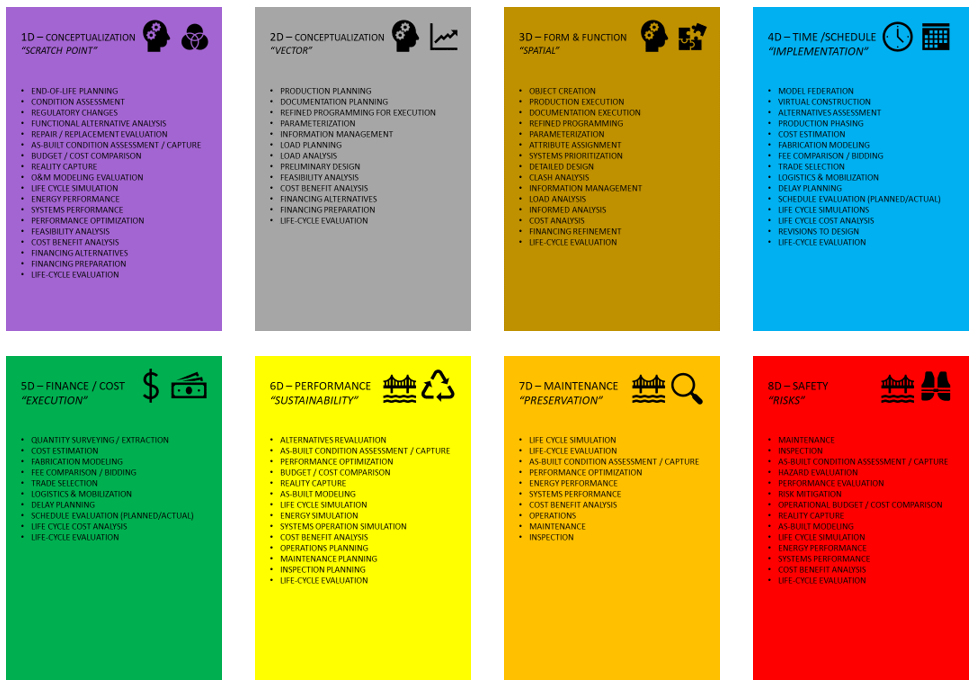
It is time to make a paradigm shift in the ways in which we deliver. Drawings, models, and even calculations when required. The standard-of-practice attitude of “this is how we have always done it,” is outdated. If you subscribe to that position from a lack of knowledge or fear of technology, you and your organization will be left behind.
Data capture and data management is the new gold for infrastructure construction. In order to keep pace with aging infrastructure and construction growth, the built environment needs to continually bring innovative solutions to all stakeholders and the general public. Advancement in digital innovations span across the spectrum of planning, design, construction, as well as the operations and maintenance of existing, planned and constructed infrastructure assets. With much of the nation’s infrastructure reaching the end of its as-designed life, and with the purchasing power of the construction dollar continuing to be stretched, developing systematic processes for determining the most cost-effective infrastructure investment strategy is of utmost importance. To accomplish this, a “base-10” pedagogy is proposed for consideration with Information Technology. If you can conceptualize Java, Python, C++, or JSON, as a basic means, you can surely visualize how to path nodes of human thought to accomplish the desired end-result.
Why “base-10” as an introduction to this concept? Base-10 is the way we assign place value to numerals – the order of things. Numbers matter at the end of the day, the quarter, the year, and over the lifecycle of the asset, personally and professionally. We take base-10 for granted and don’t use it to mine the resources that we have to execute those resources based upon that schema. When we path our thoughts for execution of a task, we are using an ordered system to structure how we approach and accomplish those tasks sub-consciously. Due to the pandemic 2020 was quite a year and required restructuring of normal routines to accomplish the same tasks and goals as before. In a very simplified manner, the order (or importance) of those tasks can be summarized in a Base-10 pedagogy.
Whether personally or for businesses – 2020 as year impacted us all forever. One socio-economic situation affected the other, personal and business. How would we adapt? Could we adapt with depth and adroitness? The workflow for design and construction needs to support all stages of the asset management process: condition assessment and data capture, data analysis, deficiency identification, cost estimating, capital investment planning and project prioritization, and OPEX budget modeling. In the past, complex tasks like organizational and operational planning, space optimization, and climate change resilience were time consuming, but with digital innovations, can be achieved much more quickly with more in-depth analysis. Each of these variables can be connected to help inform capital project development and prioritization. Data mining schemes can provide outputs and relevant parameters can be selected to suit the needs of the owner. Providing the greatest level of interoperability between common data environment platforms for effective project collaboration and delivery is key.
At the early onset of the potential for a pandemic, a strong approach was to have planned for what we would we do, how we would respond with action plans and strategies. Resiliency isn’t just backing up your data. It is being ready to protect your employees, protecting the work they do, protecting your client’s data and needs. The benefits of an innovative approach that includes a focus on 1D to 8D data capture in mind would allow for more informed operational planning and life-cycle costing and budgeting.
Whether small or large, we knew what was upon us as leaders of industry. We knew things would change. The ability to adapt to those changes efficiently and with servitude was paramount to our economy, to our business health, and to the socio-economic lives of our employees. The digital collaboration of technology leaders, engineers, information technology specialists, systems and asset management analysts, constructors and operators, creates a holistic model system for reliable operational certainty of the infrastructure asset over the long term.
When considering the 8 steps involved in an information model for this environment, we need to envision the last step first and start there. The addition of “0D” and “9D” in these steps are yours to define. Adopting an integrated approach to best leverage the most current digital technology tools lends itself to the ability to use technology to provide timely response and un-interrupted and cohesive processes to deliver what our clients need.
 Safety and protection of the human assets is paramount, all of them – starting with human infrastructure and access to information to efficiently manage their ideas and work-production efforts. The goal is a recognition that has got to be acknowledged – once again, that data is the new gold. Human data. The ability to move terabytes of information in less time is critical to success, much like our brain. Being able to break it down to palatable parts for “the Matrix” takes skill and foresight. Making it scalable and reproduceable takes “innovation.”
Safety and protection of the human assets is paramount, all of them – starting with human infrastructure and access to information to efficiently manage their ideas and work-production efforts. The goal is a recognition that has got to be acknowledged – once again, that data is the new gold. Human data. The ability to move terabytes of information in less time is critical to success, much like our brain. Being able to break it down to palatable parts for “the Matrix” takes skill and foresight. Making it scalable and reproduceable takes “innovation.”
Instead of “This situation is hard” we should ask ourselves “How and Why is this situation going to be hard” and why should we look for the answer. Frame the question and deal with that first. Who, what, when, where, and most importantly How?
Start with foundations built on strength of character and trust in the same. Introducing newer and more comprehensive technology provides enhanced design certainty (in particular, for geometric aspects) on a project whether greenfield, brownfield, or existing conditions inventory and assessment. For example, IM with LiDAR reality capture elevates the life-cycle management of the asset from the start.
To be a leader in the adoption and use of new technologies from industry partners and infrastructure owners a change in using modern technology is paramount to business success. No matter the size of the entity producing the work, scalable and affordable solutions are available to address consistent production and productivity. Change the paradigm.







































